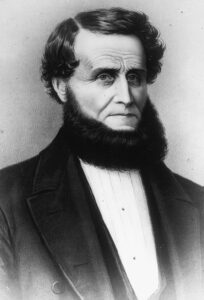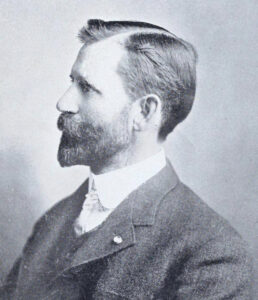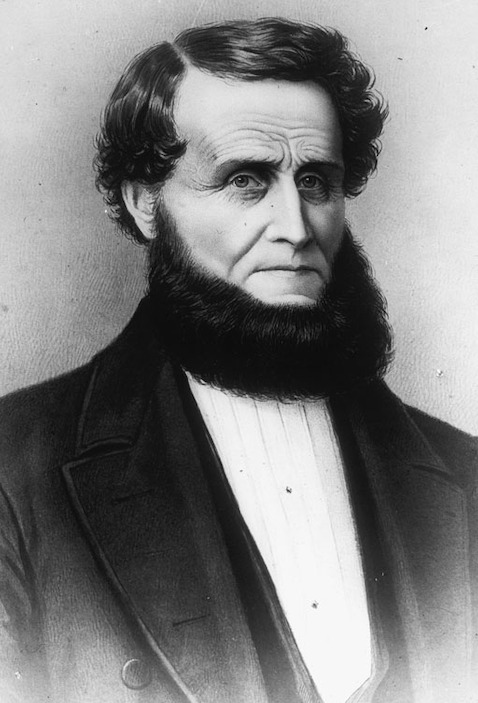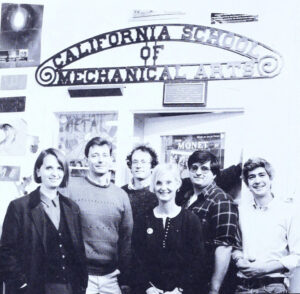Lick-Wilmerding High School calls itself “a private school with a public purpose” that stresses equity and equality. Racially and economically, LWHS is the most diverse private school in the Bay Area and has one of the best and most wide-ranging programs. This year, the number of eighth-graders applying to LWHS broke the record. Over 1,000 students sought one of the 140 spots in the class of 2026.
The Lick-Wilmering we know today is rooted in the vision and bequests of three millionaires — James Lick, Jellis Clute Wilmerding, and Miranda Wilmarth Lux — and the founding leadership of George A. Merrill. Lick, Wilmerding and Lux each endowed a school to teach students industrial and academic arts so that they would have the skills to build their lives, and help the communities in which they lived and worked to thrive.

Courtesy of the LWHS Archives
On September 21, 1875, James Lick executed his famous trust which included $540,000 in
funds to found the California School of Mechanical Arts for boys and girls and $700,000 to create the Lick Observatory, as well as other bequests for other projects to benefit the public. Overall, Lick’s will distributed $3,000,000 to seven different trustees.
The California School of Mechanical Arts, a child of his vision, opened in January 1895 and offered free education to boys and girls. James Lick began as a carpenter, turned to piano builder (both in the U.S. east coast and in Argentina), real estate investor, land baron and patron of the sciences. Lick was born in Stumpstown (now known as Fredericksburg),
Pennsylvania.
Lick arrived in San Francisco in January of 1848 with $30,000 worth of gold, (approximately $2.75 million today) and 600 pounds of chocolate to sell. Upon his arrival,
he began to buy real estate. Those who were leaving the city in search of gold wanted to sell their land in a hurry. Lick pursued properties all over the city and invested the majority
of his funds in real estate.
After the gold rush, when people returned to the city to open new businesses and families began to settle in San Francisco, Lick sold them land and houses. He made a fortune from his investments. At the time of his death, Lick was the wealthiest man in California. He died on October 1, 1876, at the age of 80.

Courtesy of the LWHS Archives
Jellis Clute Wilmerding died in 1894, leaving money in trust to the University of California to start the Wilmerding School for Industrial Arts for Boys. The school opened in 1899 in a building adjacent to Lick’s California School of Mechanical Arts.
Wilmerding was born to a well-to-do family in Moscow (now) Livingston, New York on April 28, 1833. He was educated at Temple Hill Academy in Genesco N.Y. At the age of 16, he borrowed $5,000 from his father, chartered a schooner with two of his cousins, filled the boat with merchandise to sell in the gold-crazed West and set sail to make his fortune, reaching San Francisco on September 21, 1849. His plans quickly went amuck. He was penniless.
Wilmerding headed to the gold mines but was refused work because of his age. Being too ashamed to go back to his well-to-do family in New York, who he had so boldly left, he stayed in San Francisco, found small jobs and saved money.
Wilmerding met Earl Fargo and was offered a position as a salesman in the Fargo brothers’ profitable liquor business, Fargo & Company. Wilmerding was a master at the whiskey business. In 1860, Wilmerding and Calvin Kellogg bought the company and expanded it.
Wilmerding was known to have a sympathetic nature and outstanding characteristics.
Wilmerding died in San Francisco on February 20, 1894, leaving the sum of $400,00 to the Regents of the University of California with which to establish and maintain a school to be called the Wilmerding School of Industrial Arts to teach boys trades.
The school was intended to educate boys to be able to make a living with their hands, through careful study and plenty of work. Merrill said, “What a marvelous school it would be if every boy in it would imbibe some of the spirits of the founder Wilmerding.”

Courtesy of the Miranda Lux Foundation
Miranda Lux left a portion of her estate to found the Lux School for Industrial Training for girls, which opened in 1912. For the first year, Lux shared space with the Lick School, then in 1913 moved into its own building.
Lux’s maiden name was Miranda Wilmarrth Sheldon. She was born in Cranston, Rhode Island on December 23, 1825. She was known to be a modest woman of simple tastes.
Lux had married Jesse Potter in 1846. Together they
moved to San Francisco in 1848. Potter died in 1854 in an accident. On February 10, 1857, Lux married Charles Lux. Lux was a partner in Lux and Miller, a cattle raising operation with vast land holdings.
Lux had always had a deep interest in philanthropic
work with children. For many years she was the director of the San Francisco Protestant Orphanage. Lux worked closely with Sarah B. Cooper who was considered the mother of the kindergarten movement in California. Her legal advisor was Thomas B. Bishop who was an advocate for industrial education and interested in both agriculture and mining. Lux died in September 1894 in San Francisco, leaving 750,000 to found a school for boys and girls. Bishop became a trustee of the Lux school, which opened for girls only.

Courtesy of the LWHS Archives
George A. Merrill, a graduate of the University of California, Berkeley and a powerful figure in the industrial education movement, was the founding director of the California School for the Industrial Arts. He was also appointed director of the Wilmerding School of Industrial Arts and the Lux School for Industrial Training for Girls. The Wilmerding and Lux schools were adjacent to the Lick campus at 17th Street & Potrero Avenue in the Mission District. They shared facilities
and some programs but remained separate entities.
Merrill’s official connection to Lick’s California
School of Mechanical Arts began on began, on June 1, 1894. During the month of June 1894, the course of study was formulated and plans for the building were completed.
Construction of the school began in early July and
proceeded rapidly. The buildings were ready to dedicate on Monday, January 7, 1895, and students were enrolled during the same week, with a founding class of 106 boys and 30 girls. Lick’s school, which centered industrial and vocational education along with academics was quite different from anything that had been seen before.
In early 1939, the California School of Mechanical Arts and the Wilmerding School of Industrial Arts merged to become Lick-Wilmerding High School. The Lux School became a college and then closed in 1954.
Lick-Wilmerding High School, a boys only school, moved to its new campus at 755 Ocean Avenue in the summer
of 1955.







